Astronomy - This Week’s Sky at a Glance, December 23 – 31
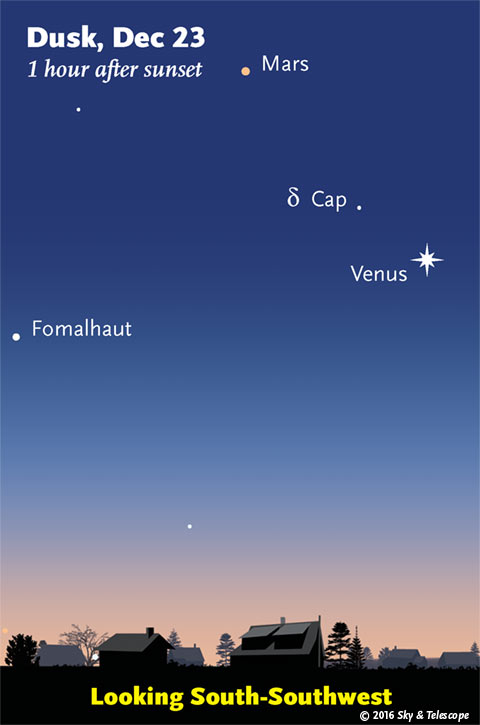
The temporary "Southwest Triangle" of Venus, Mars and Fomalhaut continues to shrink, as Venus approaches Mars and the stars slide westward behind the planets.
Friday, December 23
• Sirius and Procyon in the balance. Sirius, the Dog Star, sparkles low in the east-southeast after dinnertime. Procyon, the Little Dog Star, shines in the east about two fist-widths at arm's length to Sirius's left.
If you live around latitude 30° (Tijuana, New Orleans, Jacksonville), the two canine stars will be at the same height above your horizon soon after they rise. If you're north of that latitude, Procyon will be higher. If you're south of there, Sirius will be the higher one.
Saturday, December 24
• This is the time of year when M31, the Andromeda Galaxy, passes your zenith soon after dark (if you live in the mid-northern latitudes. It goes precisely across your zenith if you live at latitude 41° north.) Binoculars show M31 just off the upraised knee of the Andromeda constellation's stick figure; see the big evening constellation chart in the center of Sky & Telescope.
Sunday, December 25
• Right after dark you'll find the Pleiades high in the east, with Aldebaran and the Hyades below them. Far below these, Orion is beginning to clear the horizon. By about 9 p.m. Orion is much higher and Sirius is sparkling below it, completing this famous tall stack of December stars.
• Merry Sol Invictus! In late Roman times when the solstice fell on December 25th, the date was celebrated as Dies Natalis Solis Invicti, the Birthday of the Unconquered Sun — when the Sun began to reverse its long decline with the hopeful promise, in the cold and the dark, of a new spring and summer to come. When Christianity took over the Roman Empire, it took over the symbolism and the date.
• Got a new scope for Christmas? Not exactly sure what to do with it? Read What to See with Your New Telescope.
Monday, December 26
• Saturn already? Antares already? Before 2017 even begins, you can catch the very beginning of their apparition that will culminate in the warm evening sky next summer. In early dawn tomorrow the 27th, if air is very clear, go out and look very low in the southeast. Saturn is below the thin waning crescent Moon, and twinkly Antares is off to their right, as shown above.
Binoculars will help. The best viewing will probably be about 45 to 35 minutes before your local sunrise time. (Though in a telescope, Saturn so low will look awfully blurred through the thick air.)
Tuesday, December 27
• Venus now stays up a full two hours after complete darkness (at least if you can see down to the west-southwest horizon). So you have plenty of time this evening to notice that just to Venus's left it little Delta Capricorni, magnitude 2.8. They're 1.1° apart (for North America). And below Venus by about 1.4° is fainter Gamma Cap, magnitude 3.6.
Wednesday, December 28
• After dinnertime at this time of year, the Great Square of Pegasus balances on one corner high in the west. The vast Andromeda-Pegasus constellation complex runs all the way from near the zenith (Andromeda's foot) down through the Great Square (Pegasus's body) to fairly low in the west (Pegasus's nose).
Thursday, December 29
• Orion is now up in the east-southeast soon after nightfall, with his three-star Belt nearly vertical. The Belt points up toward Aldebaran and, even higher, the Pleiades. In the other direction, it points down to where bright Sirius will rise around 7 or 8 p.m. (depending on your location) and twinkle furiously.
• New Moon (exact at 1:53 a.m. on the 29th Eastern Standard Time). A new lunar month begins. Unlike a calendar month, which averages 30.437 days long, a lunar month (from one new Moon to the next) averages 29.531 days. This means that, on average, you'll see the Moon in the same phase about one day earlier every calendar month.
Friday, December 30
• Can you spot the fingernail-thin crescent Moon in twilight? It's less than two days old as seen after sunset for North America. Look low in the southwest 30 to 50 minutes after the Sun goes down. The Moon is located about 30° (three fists at arm's length) to the lower right of shiny Venus.
A similar distance to the Moon's upper right sparkles Altair.
Saturday, December 31
• After the noise and whoopla at the turning of midnight tonight, step outside into the silent, cold dark. Shining in the south will be Sirius at its highest. The other bright stars of Canis Major will be to its right and below it. Sirius forms the bottom of the bright, equilateral Winter Triangle. The triangle's other stars are Betelgeuse in Orion's shoulder to Sirius's upper right, and Procyon the same distance to Sirius's upper left. The Winter Triangle now stands upright just about in balance.
_________________________
Want to become a better astronomer? Learn your way around the constellations! They're the key to locating everything fainter and deeper to hunt with binoculars or a telescope.
This is an outdoor nature hobby. For an easy-to-use constellation guide covering the whole evening sky, use the big monthly map in the center of each issue of Sky & Telescope, the essential guide to astronomy.
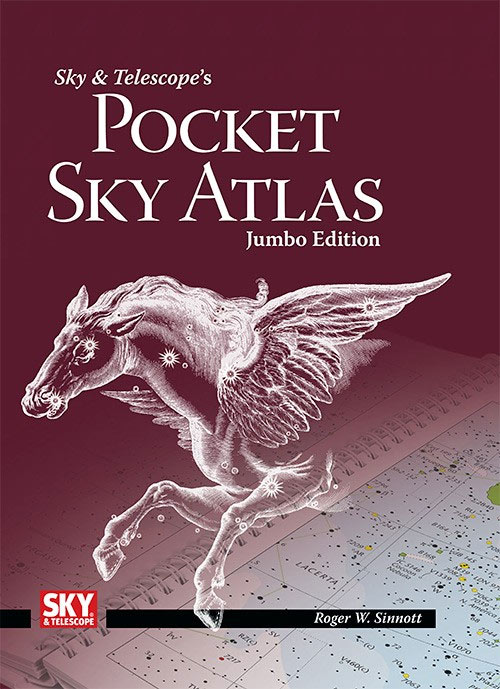
The Pocket Sky Atlas plots 30,796 stars to magnitude 7.6 — which may sound like a lot, but it's less than one per square degree on the sky. Also plotted are many hundreds of telescopic galaxies, star clusters, and nebulae. Shown above is the new Jumbo Edition for easier reading in the night. Click image for larger view.
Once you get a telescope, to put it to good use you'll need a detailed, large-scale sky atlas (set of charts). The basic standard is the Pocket Sky Atlas (in either the original or new Jumbo Edition), which shows stars to magnitude 7.6.
Next up is the larger and deeper Sky Atlas 2000.0, plotting stars to magnitude 8.5, nearly three times as many. The next up, once you know your way around, is the even larger Uranometria 2000.0 (stars to magnitude 9.75). And read how to use sky charts with a telescope.
You'll also want a good deep-sky guidebook, such as Sue French's Deep-Sky Wonders collection (which includes its own charts), Sky Atlas 2000.0 Companion by Strong and Sinnott, or the bigger Night Sky Observer's Guide by Kepple and Sanner.
Can a computerized telescope replace charts? Not for beginners, I don't think, and not on mounts and tripods that are less than top-quality mechanically (meaning heavy and expensive). And as Terence Dickinson and Alan Dyer say in their Backyard Astronomer's Guide, "A full appreciation of the universe cannot come without developing the skills to find things in the sky and understanding how the sky works. This knowledge comes only by spending time under the stars with star maps in hand."
This Week's Planet Roundup
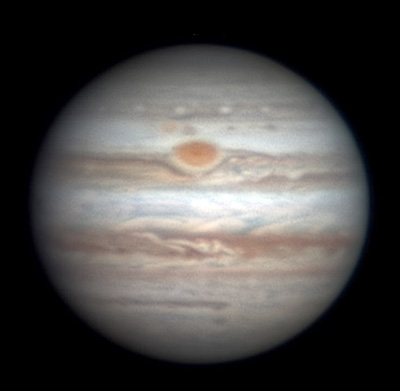
Jupiter's Great Red Spot side. . .
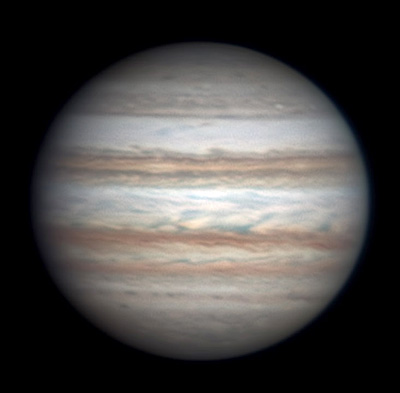
. . .and non-Red-Spot side, imaged by Christopher Go on November 30th and 27th, respectively. South is up. With Jupiter in fine telescopic view pre-dawn, it's showing a huge white zone south of the brownish South Equatorial Belt, but nothing like that in the northern hemisphere. A very small telescope should be able to show the difference.
Mercury has faded from view in the glow of sunset.
Venus (magnitude –4.4, in Capricornus) is the bright white "Evening Star" blazing in the southwest during and after twilight. In a telescope, it's a brilliant gibbous disc (about 60% sunlit) 20 arcseconds in diameter.
Mars (magnitude +0.8, in Aquarius) still glows in the south-southwest at dusk, about 15° upper left of Venus. In a telescope it's a tiny orange blob only 6 arcseconds in diameter.
Jupiter (magnitude –1.9, in Virgo) rises around 1 a.m. and shines brightly high the south-southeast by early dawn. Spot Spica 5° below it. In a telescope, Jupiter is 35 arcseconds in diameter: relatively small as Jupiter goes.
Saturn is deep in the glow of sunrise.
Uranus (magnitude 5.8, in Pisces) and Neptune (magnitude 7.9, in Aquarius) are in the southern sky right after dark. Info and finder charts.
__________________________
All descriptions that relate to your horizon — including the words up, down, right, and left — are written for the world's mid-northern latitudes. Descriptions that also depend on longitude (mainly Moon positions) are for North America.
Eastern Standard Time (EST) is Universal Time (UT, UTC, or GMT) minus 5 hours.
__________________________
"This adventure is made possible by generations of searchers strictly adhering to a simple set of rules. Test ideas by experiments and observations. Build on those ideas that pass the test. Reject the ones that fail. Follow the evidence wherever it leads, and question everything. Accept these terms, and the cosmos is yours."
— Neil deGrasse Tyson
— Neil deGrasse Tyson
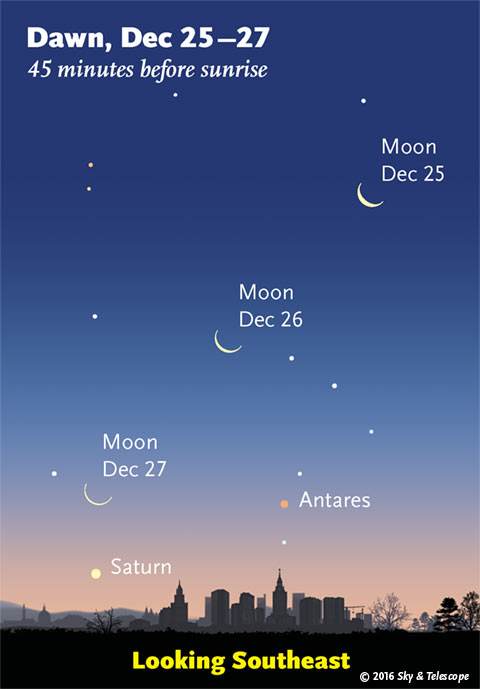
No comments:
Post a Comment